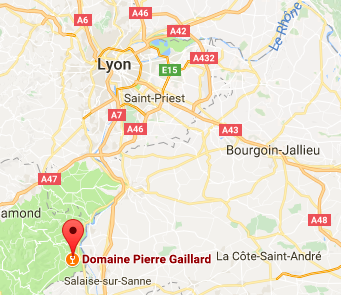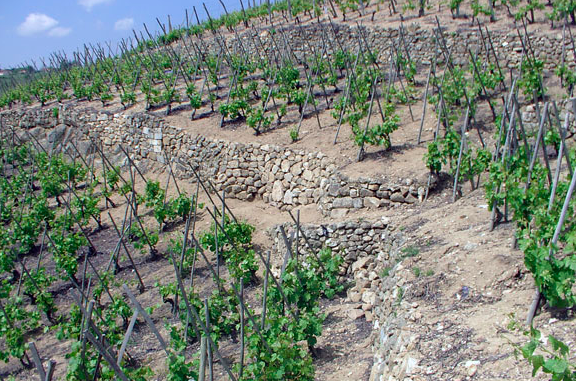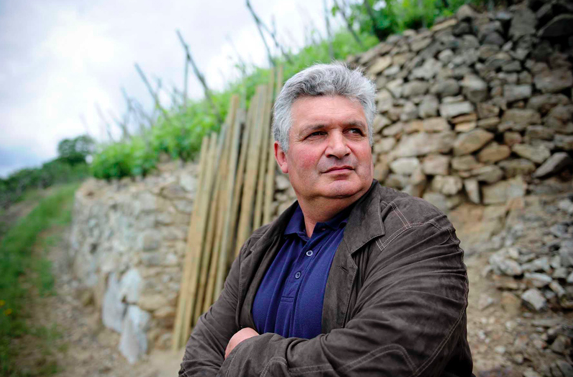
The Estate

Pierre Gaillard studied Viticulture and Enology in Beaune, and obtained a Graduate Diploma in Winemaking from Montpellier. He bought his first parcel of land in 1981 which was called Clos de Cuminailles, located in Malleval. It was there in the upper part of the medieval town of Malleval that Gaillard established his business. In 2002, he created the estate of Madeloc in Banyuls-sur-Mer, followed by the estate of Cottebrune in Faugères in 2007. Today, Gaillard manages a total of 77 hectares.
The vineyard is located in the northern part of the Rhone Valley, ranging from Cote-Rotie down through to Cornas in the South. Planted on steep slopes, the vines are located on the last foothills of the Massif Central.

The Vines
Environmental grape growing techniques are implemented on the three estates. The use of organic fertilizers is adjusted to each vineyard’s needs. High plantation density allows the roots to develop and helps to regulate the yield. The soils are tilled to push the roots to grow deep into the soil, letting the vines benefit from the terroir’s natural resources.
Pierre Gaillard tries to make sure that the phenolic maturity of the grapes is achieved around the same time as their alcoholic maturity. The implementation of leaf-fining and green harvesting increases the foliage exposed to the sunlight, thereby directly influencing the wines’ structure and color.
 Surface Area
Surface Area
25 hectares
Soils
Decomposing schist (Côte-Rôtie), altered granite (Saint-Joseph, Condrieu and Côtes-du-Rhône). Parent rock on the surface of several parcels. Light, well-drained and warm soil.[/accordion_section]
Grape Varietals
Red: Syrah
Whites: Viognier, Roussanne
Yield
120,000 bottles/year

Asiaticus
Overview: This wine reflects its terroir of slopely schist facing south on the left bank of the Rhône. During the Roman era, this area used to produce the reputed wines of Terres de Viennae.
Terroir: Asiaticus is certainly the most famous person from Vienne (France) during the Gallo-Roman era (1st century AD). He was a senator and then a consul in Rome. He knew the Emperors and participated in the elimination of Caligula and the rise of Claudius. He was a rich patron and owned land within the territory of the city of Vienne. He was the important figure at the time, largely contributing to the notoriety of the Wines of Vienne throughout the Empire and especially in Rome. From a geological point of view, the schist rock bordering the Massif Central to the east was split by a fault when the Alps emerged. The Rhône found its path when this area collapsed, separating a small block of schist on the other bank. The curve of the Rhône near the city of Vienne orients these slopes on the south side by offering them a perfect protection against the cold winds of the north. According to legend, the Romans produced their best wines-Sotanum, Taburnum, and Helicum-from this terroir.
Surface Area: About 1 ha
District: Seyssuel
Varietal Blend: 100% Syrah
Soils: Slope facing southwest, schist
Yield: 30 hl/ha
Vinification: Handpicked harvest, sorting of healthy and well-ripened grapes. Total destemming. Cold fermentation before maceration, alcoholic fermentation at 35°C. Maceration following fermentation at 30°C. Malolactic fermentation in barrels. Cap-punching, pumping over and release techniques help to thoroughly extract the aromas and the tannins associated with the terroir of Seyssuel.
Aging: 18 months in fine oak from Allier and Nevers. Barrels: 50% new with oxygen added every 4 months.
Tasting Notes: The special character of this terroir is well reflected by this wine. It expresses both strength and elegance with good balance. It can be consumed in its youth, but also after 10-15 years of aging.

Condrieu
Terroir: The terroir of Condrieu is ideal for growing Viognier, giving the grapes the perfect environment to express their aromatic potential. It has just the right balance of granite soils and continental climate. The slopes, sometimes steep, and the south-southeast orientation shelters the vines from the cold north winds.
Communes: Chavanay, Malleval, Condrieu
Production Area: 5 hectares
Exposition: South, southeast
Grape Varieties: 100% Viognier
Average Age of the Vines: 20 years old
Soil: Granite sands
Plant Density: 10,000 vines/hectare
Training Method: Guyot trellised on poles
Average Yield: 40 hl/ha
Harvest: The harvest is manually done at peak maturity of the grapes. Sorting on the vine if required.
Vinification: After gentle pressing and clear settling, the musts are vinified in barrels (no new oak). Alcoholic fermentation at about 16-18°C. Malolactic fermentation.
Aging: 9 months in barrels. Batonnage (stirring) on the lees.
Tasting Notes: This elegant and complex wine offers notes of exotic fruits, peach, and acacia. The mouth is ample, round, and subtle, with a long, mineral finish.
Cellaring: To be consumed within 15 years of vintage.

Condrieu L’Octroi
Overview: Fruity, elegant and mineral. This wine is elaborated from a selection of parcels planted a dozen years ago, on the rocky and mineral slopes of the Malleval Gorges.
Terroir: Following the plantation of the vines, the soil was ploughed-with a winch in certain areas. As a result, the roots make their way down to the heart of the terroir and benefit from its mineral characteristics.
Surface Area: 1 ha
Varietal Blend: 100% Viognier
Soils: Fine sand made up of detrital granite facing directly south
Yield: 30 hl/ha
Vinification: Handpicked harvest of well-ripened grapes. Alcoholic fermentation in barrels, controlled temperature between 15 and 18°C. Malolactic fermentation in barrels. Viognier produces rich and aromatic wines. This product is fermented in barrels thereby offering just the right oxygenation to highlight its aromas, all the while avoiding heaviness. The mineral characteristics of the terroir come to the fore, bringing out a sensation of freshness.
Aging: 7 to 8 months in fine grain oak barrels (Allier and Nevers). 5% at the most in new oak. Stirring on lees once a week. The wines are matured and stirred on lees during the entire maturing period in view of preserving their mineral notes, all the while enriching their structure on the palate.
Tasting Notes: Tropical fruit and flower aromas: lychees, white peaches, and violets; lovely minerality and freshness.

Cornas
Terroir: The plot of Cornas is located at the bottom of the hill, on deep soils of highly eroded granite. The climate is continental with Mediterranean influences.
Production Area: 1.5 hectares
Commune: Cornas
Grape Varieties: 100% Syrah
Average Age of the Vines: 70+ years old
Training Method: Trellised goblet on stakes
Plant Density: 10,000 vines/hectare
Soil: Highly weathered granite
Exposition: South and east
Average Yield: 40 hl/ha
Harvest: The harvest is manually done at peak maturity of the grapes. Sorting on the vine if required.
Vinification: The vinification is traditional. The harvest is totally destemmed so that the wine retains all its elegance. Pre-fermentation maceration at cold temperatures, and post-fermentation at 30°C. Fermentation at 30°C. Malolactic fermentation in barrel. The extraction is soft and long so as to obtain silky tannins.
Aging: 18 months in oak barrels (30% new wood)
Tasting Notes: This Syrah is powerful, elegant, rich, and unctuous, with velvety tannins.
Food Pairings: Serve with grilled meats and vegetables.
Cellaring: To be consumed within 10 years of vintage.

Côte-Rôtie
Terroir: The vines are planted on steep hillsides with an exposition to the south/southeast within the municipalities of Ampuis, Tupin, and Semons. The plots located farther north of the appellation are planted on soils composed of brown shale rock rich in iron oxide, whereas farther south the eroded Gneiss soils are more clayey and siliceous.
Production Area: 5 hectares
Grape Varieties: 90% Syrah, 10% Viognier
Average Age of the Vines: 30 years old
Plant Density: 10,000 vines/hectare
Training Method: Trellised goblet on stakes
Average Yield: 40 hl/ha
Harvest: The harvest is manually done at peak maturity of the grapes. Sorting on the vine if required.
Vinification: Total destemming. Pre-fermentation maceration at cold temperatures, and post-fermentation at 30°C. Fermentation at 30°C. Malolactic fermentation in barrel. The extraction is long and gentle so as to obtain silky tannins. Each parcel is vinified and aged separately in order to preserve its unique characteristics. The wine is then blended to obtain a better balance between the power and the elegance of these terroirs.
Aging: 18 months in oak barrels (30% new wood).
Tasting Notes: The Côte-Rôtie is expressive and subtle at the same time. Delicate notes of blackcurrant at the start, with aromas of violet and black pepper. The velvety tannins linger on the palate. The finish has a harmonious, light, airy quality.
Cellaring: This wine drinks well in its youth, and develops delicious complexity with 10-15 years aging.

Côte-Rôtie Esprit de Blonde
Grape Varieties: 90% Syrah, 10% Viognier. The grapes come exclusively from the Côte Blonde
Vinification: Destemmed, 5-7 day pre-fermentation cooling at <10°C, 4-week vinification at up to 35°C, 3 daily cap punchings, pumping-over, part vat emptying/refilling, with maceration at 30°C.
Aging: 50% new wood (down from 100% in early 2010s), 50% 1-year 228-litre oak casks (Allier, Nevers) for 18-20 months, with malo completed in the casks, oxygenated every 4 months, unfiltered.
First Vintage: 2012
Production: Approx. 2,000-2,200 bottles

Côte-Rôtie Rose Pourpre
Terroir: The parcel of Côte Rozier is located in an amphitheater facing south, with many dried stone walls restituting the warmth of the sun. This special situation translates to a particularly hot micro-climate.
Surface Area: 0.8 ha
District: Ampuis (Rhône)
Varietal Blend: 100% Syrah
Soils: Brown schist, rich in iron oxide
Yield: 35 hl/ha
Vinification: Handpicked harvest, sorting of the healthy and well-ripened grapes. Total destemming. Cold maceration before fermentation. Alcoholic fermentation at 35°C. Maceration after fermentation at 30°C. Malolactic fermentation in barrels. Cap punching three times a day, pumping over and release techniques allow for the good extraction of the aromas and the tannins. Placed in barrels before malolactic fermentation, this wine blends gradually with the oak producing pleasant melted aromas.
Aging: 18 months in fine oak from Allier and Nevers. Barrels 50% new with oxygen added every 4 months. After the maturing, the best barrels are selected in view of obtaining the most subtle balance between the strength and the finesse of the terroir of Côte Rozier.
Cellaring Potential: It is best to keep this wine in the cellar for a minimum of 3 years. It can be aged for up to 15 years.

Cotes du Rhone Blanc Les Gendrines
Terroir: The vines are planted on fine granite-laden sandy hillsides, facing east, contrary to the parcels of Condrieu. This cooler exposition allows the berries of Viognier to develop good acidity, joined by richness and maturity brought about by the limited yield.
Surface Area: 1.5 ha
Districts: Chavanay, Malleval (Loire), Limony (Ardèche)
Varietal Blend: 100% Viognier
Soils: Fine soil composed of detrital granite
Vinification: Handpicked harvest, sorting of the healthy and well-ripened grapes. Alcoholic fermentation in barrels, at a controlled temperature between 15-18°C. Malolactic fermentation in barrels. The fermentation in barrels enables the wine to fully express its aromatic potential. The limited use of new oak (a mere 10%) allows the Viognier to fully express its finesse and freshness, brought about by the granite from the northern part of the Rhône Valley.
Aging: 7 to 8 months in fine oak from Allier and Nevers. 5% in new oak. Stirring on lees once a week. The stirring and the use of lees during the entire maturing period preserves the wines mineral characteristics all the while enriching the structure on the palate. This technique makes the wine more unctuous and creates roundness as well as volume.
Tasting Notes: Bright color typical of the variety. Floral nose with aromas of white flesh fruit. The mouth is full and finished with some minerality typical of the terroir. Ready to drink.
Serving Notes: Serve between 10- 12˚C. Pairs well with goat cheeses, pâtés, terrines, white meats, or simply as an aperitif.

Crozes-Hermitage
Terroir: The soil is made up of well-draining rolled pebbles that were deposited by the rivers at the confluence of the Isère and the Rhône. The stones store the heat well and thus promote a beautiful expression of Syrah in the resulting wine.
Production Area: 5 hectares
Communes: Chanos Curson, Veaune, Beaumont, Monteux
Grape Varieties: 100% Syrah
Soil: Rolled pebbles
Average Yield: 45 hl/ha
Training Method: Cordon de Royat trellised on wire
Plant Density: 6,000 vines/hectare
Average Age of Vines: 30 years old
Harvest: Mechanically and manually done at full maturity of the grapes.
Vinification: Total destemming. Pre-fermentation maceration at cold temperatures, and post-fermentation at 30°C. Fermentation at 30°C. Malolactic fermentation in barrel. The extraction is soft and long so as to obtain silky tannins.
Aging: 18 months in oak barrels
Tasting Notes: The nose is refined, with notes of red berries and spices. The palate is vinous, structured, and delicate.
Food Pairing: Goes well with rabbit, chicken thighs, duck, or soft, creamy cheeses like Saint Marcellin.
Cellaring: To be consumed within 5 years of vintage.

Saint-Joseph Blanc
Overview: Intensely fresh, complex and aromatic. Made from Roussanne, cultivated on the upper part of Malleval and of Chavanay
Terroir: Saint-Joseph white wines are traditionally made from a blend of Roussanne et Marsanne. Pierre Gaillard only uses Roussanne, as this variety produces wines with interesting complexity and good rich characteristics. Harvested when fully-ripened from vineyards planted in the granite-laden soils situated north of the appellation, this wine expresses complexity and good mineral features including during hot years.
Surface Area: 2.3 ha
Districts: Chavanay, Malleval (Loire)
Varietal Blend: 100% Roussanne
Soils: Fine sand composed of detrital granite
Yield: 25 hl/ha
Vinification: Handpicked harvest, sorting of healthy and well-ripened grapes. Alcoholic fermentation in barrels. Controlled temperatures (15-18°C). Malolactic fermentation in barrels. The low yield reinforces the richness and the aromatic complexity of the Roussanne grape variety. The wine is protected from oxidation
to avoid heaviness and to bring out the terroir’s natural mineral characteristics.
Aging: 7 to 8 months in fine oak from Allier and Nevers. 5% in new barrels. The wines are matured and stirred on lees once a week during the entire period to preserve their mineral characteristics all the while enriching their structure on the palate.
Cellaring Potential: Can be consumed in its youth, however will also age very well and harmoniously for 5 to 6 years.

Saint-Joseph Rouge
Terroir: This Saint-Joseph comes from the north of the appellation. The granite is very draining and this characteristic is accentuated by the slopes. The continental climate with Mediterranean influence offers scanty but regular rains, limiting the problem of drought on this terroir.
Communes: Chavanay, Malleval, Sarras
Production Area: 10 hectares
Exposition: East, southeast
Grape Varieties: 100% Syrah
Training Method: Cord of royat and Goblet
Average Age of the Vines: 20+ years old
Soil: Granite sands
Plant Density: 6,500 vines/hectare
Average Yield: 40 hl/ha
Harvest: The harvest is manually done at peak maturity of the grapes. Sorting on the vine if required.
Vinification: Total destemming so that the wine retains all its elegance. The extraction is soft and long so as to obtain silky tannins. Pre-fermentation maceration at cold temperatures, and post-fermentation at 30°C. Fermentation at 30°C. Malolactic fermentation in barrel.
Aging: 15 months in oak barrels (no new wood). Regular oxygenation during the aging process so that the fruit will be expressed.
Tasting Notes: The nose is reminiscent of a basket of red fruits, with hints of gingerbread. On the palate, this Saint-Joseph is frank with delicacy and suppleness.
Cellaring: To be consumed within 5 years of vintage.

Saint-Joseph Les Pierres
Overview: Refined and aromatic. Elaborated from the best wines in the cellar, following several selections.
Terroir: Les Pierres is the fruit of a double selection. As of the harvest, all of the terroirs are separated. The best harvests produced at Clos de Cuminaille but also at Côte Belley and Limony are identified and matured in new barrels. As a result, this wine is derived from well-exposed hillsides, composed of granite with fine soil offering good drainage and conditions allowing the Syrah grape variety to fully express its characteristics.
Surface Area: 1.5 ha
Districts: Chavanay, Malleval (Loire), Limony (Ardèche)
Varietal Blend: 100% Syrah
Soils: Altered granite
Yield: 35 hl/ha
Vinification: Annual harvest, selective sorting of healthy and well-ripened grapes. Total destemming. Cold maceration before fermentation, alcoholic fermentation at 35°C. Maceration at 30°C after fermentation. Malolactic fermentation in barrels. Cap punching three times a day, as well as pumping over and release techniques skilfully extracting aromas and tannins. Placed in barrels before the malolactic fermentation, the wine combines well with oak, producing pleasant melted aromas.
Aging: 18 months in fine oak from Allier and Nevers. 100% new oak barrels with racking every three months. In March, when the wine is blended, only 20-25% of the barrels expressing the most aromatic complexity will become Les Pierres. This special elegance will entirely come to the fore after 10 years aging.
Tasting Notes: Savory with silty, polished berries and plum skins–ripe and sweet, this is bright and taut and yet supple and inviting. Balanced, with a crescendo of fruit and then spice.


